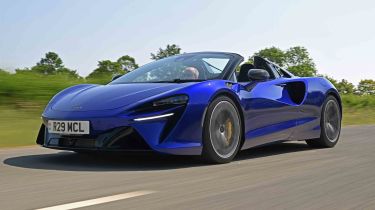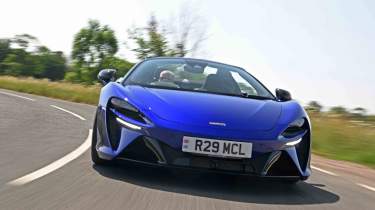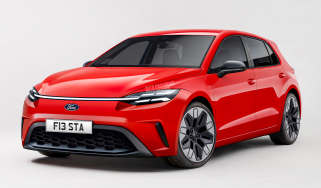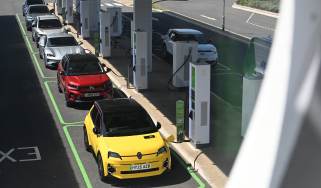McLaren Artura review
The McLaren Artura is a Brit-built supercar that combines hybrid technology with turbo power for a thrilling drive

Our opinion on the McLaren Artura
Integrating hybrid power into a supercar isn’t an easy task, but the McLaren Artura does a decent job on the whole. Updates introduced with the arrival of the McLaren Artura Spider have helped, while the car’s outstanding combination of sharp handling with accurate steering and a sublime ride when you’re taking things easy makes it far easier to forgive a slight lack of finesse with the car’s electrical system. As with any plug-in supercar, the hybrid element has been added to boost the car’s performance, with improved fuel efficiency being a beneficial by-product.
| Key specs | |
| Fuel type | Petrol plug-in hybrid |
| Body style | Two-door mid-engined coupé Two-door mid-engined Spider |
| Powertrain | 3.0-litre twin-turbo V6, plus electric motor, rear-wheel drive |
| Safety | Not tested by Euro NCAP |
| Warranty | Five years/unlimited miles |
About the McLaren Artura
For a supercar company that was only established in 2010, McLaren Automotive has been hugely prolific when it comes to introducing new models. The MP4-12C was swiftly followed by the 650, then 675LT, 720 and 765LT incarnations, while the smaller 570 spawned the 600 and 620R variants, all within the space of a decade. In 2023, the 570 range was superseded by the Artura, which was a brand-new model from the ground up.
The Artura is offered in coupe and Spider guises, but the only real difference between the two is an extra 62kg that the latter carries for its opening roof – the arrival of the Spider in 2024 did bring some upgrades, although these have been applied to both versions.
Used - available now

2024 Volkswagen
Polo
26,127 milesAutomaticPetrol1.0L
Cash £17,375
2022 Peugeot
308 SW
45,289 milesAutomaticPetrol1.2L
Cash £16,025
2024 Peugeot
2008
14,766 milesAutomaticPetrol1.2L
Cash £17,025
2024 Toyota
Aygo X
26,564 milesAutomaticPetrol1.0L
Cash £13,350Under the skin, the Artura uses McLaren’s new MCLA (McLaren Carbon Lightweight Architecture) chassis, while power comes from an all-new 3.0-litre twin-turbo V6 combined with an electric motor and drive battery. This makes a total of 690bhp (an increase of 20bhp was introduced with the Spider, and has also been applied to the coupé) and there’s 720Nm of torque, 585Nm of which is made by the engine. Power is fed to the rear wheels via an eight-speed twin-clutch gearbox.
Performance & driving experience
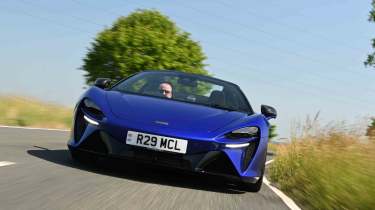
| Pros |
|
| Cons |
|
Smoothly integrating a petrol-electric powertrain into a performance car seems to be the current holy grail for many sports car makers. For the McLaren Artura, the British firm has introduced a new engine to make it happen, with a powertrain based around a new 3.0-litre twin-turbocharged V6. This is in a so-called ‘hot vee’ layout, with the turbos nestled between the two cylinder heads that are set at an angle of 120 degrees, which is a unique configuration in the new-car market.
The engine is joined by an electric motor and a 7.4kWh battery, with the whole system offering a total of 690bhp – the arrival of the Spider saw an extra 20bhp added to the maximum – while there’s 720Nm of torque, 585Nm of which comes from the engine. The engine is connected to an eight-speed twin-clutch automatic gearbox, while the Artura is the first McLaren road car to come with an electronic limited-slip differential.
The suspension is handled by double wishbones up front and a multi-link set-up at the rear, while standard-fit adaptive dampers offer a wide range of adjustment. Carbon-ceramic brakes are also fitted as standard, while a range of drive modes are offered via two rocker switches located on the leading edge of the dashboard display. The one on the left changes the damping between Comfort, Sport and Track settings, while the one on the right adjusts powertrain response, with the same modes as the damping, but also an Electric setting for zero-emissions running.
Performance, 0-60mph acceleration and top speed
Launch control comes as standard on the Artura, with additional electronics in the shape of McLaren’s ‘Spinning-Wheel Pull Away’ system. Use this system, and you’ll be able to sprint from 0-62mph in three seconds exactly, and it’s the same figure whether you’re looking at the coupé or the Spider. The top speed is 205mph for both cars, too.
Town driving, visibility and parking
Supercars aren’t really designed for urban use, but the Artura has some features that help make it more manageable than some rivals. Front and rear parking sensors and 360-degree cameras are fitted, and the former are very pessimistic in judging distances, ensuring that the car’s expensive carbon fibre bodywork doesn’t come into contact with the surroundings. Reverse is handled by the electric motor alone, so you can manoeuvre in silence, too.
The power steering is an electro-hydraulic set-up, so it’s quite weighty to move at parking speeds, but once you increase your pace it remains heavy, but is more manageable. Even more impressive is the Artura’s low-speed ride quality. In Comfort mode, the adaptive dampers do a great job of absorbing shocks, with only the biggest bumps causing the car to be unsettled. Set the powertrain to Electric using the large rocker switch on the top right of the dials and the Artura runs in virtual silence, with just a hint of whine from the transmission that’s somewhat reminiscent of a straight-cut gearbox.
Comfort mode sees the engine stay silent as long as there’s some charge in the battery, but even when the V6 fires up, it’s still fairly quiet, unless you’re in Sport or Track settings. Acceleration is easily controlled with the responsive throttle pedal, with the transition between electric and petrol mode fairly smooth, too. Short gearshifts in Comfort mode help keep the revs low, and the Artura is a breeze to drive at urban speeds. The brakes are a little grabby, but that’s often a criticism of carbon-ceramic set-ups which are designed to work at higher speeds and temperatures.
B-road driving and handling
What really sets the Artura apart from many other performance cars is how fluid and connected the steering feels. The electro-hydraulic set-up is quick, perfectly weighted and full of feedback, allowing you to position the car precisely and with full knowledge of the surface beneath you and what the front tyres are doing.
The damping is another revelation. Even in the hardest Track setting there’s still some compliance, although the stiff chassis does mean every lump and bump can be felt in this mode, so it’s probably best left to when you’re driving solo. Sport mode offers a good balance between firmness and bump absorption, but even the Comfort setting still delivers a good mix and is probably what we’d stick with on UK roads.
There are distinct steps in the character of the powertrain when you switch between Comfort, Sport and Track modes, with sharper throttle response and more input from the petrol V6 – the engine is permanently running to ensure it’s ready for the next burst of acceleration. There’s no turbo whoosh as you get when accelerating in a Ferrari 296, but the engine delivers a hard, metallic note that sounds purposeful, with rumbles from the exhaust as you lift off.
The gearbox feels great to use, with a single piece of metal for the up and downshift paddles and a rocker action as you shift through the gears. There are more aggressive shifts in the sportier modes, but each ratio slots home quickly and without much jerkiness.
Motorway driving and long-distance comfort
It’s best to select Comfort mode once more on the motorway, because then you can simply revel in the Artura’s sublime damping. Let the engine tick over at low revs in eighth gear and the car simply cruises along without breaking a sweat, and the steering barely needs any guidance beyond looking where you want to go and giving the wheel a gentle nudge in the right direction. The only blots on the copybook are the slightly limited rear visibility and the road noise from the wide tyres.
Model |
Power |
0-62mph |
Top speed |
| Artura coupé/Spider | 690bhp | 3.0 seconds | 205mph |
“The Artura Spider doesn’t lose anything to the coupé in terms of performance, and the added dimension of the open top means you can hear the V6 engine even better. The rear window drops so you can take it in even when the weather is poor, and the screen also doubles as a wind break to help minimise buffeting with the top down.” – Dean Gibson, senior test editor
MPG & running costs
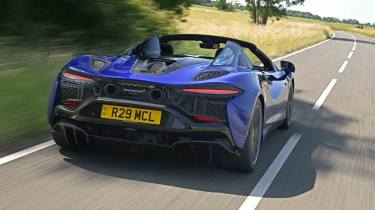
| Pros |
|
| Cons |
|
A £200,000 supercar is never going to be a machine with penny pinching in mind, but the figures for the Artura are impressive when you consider the performance on offer. McLaren quotes official WLTP fuel economy of 58.9mpg, which applies to both the coupé and Spider. That’s better than the more expensive (and more powerful) Ferrari 296, which is in the 31-32mpg range.
In reality, you’re never going to get near that figure if you drive the Artura the way it’s supposed to be driven, and the electronic management system switches between electric and petrol power as it sees fit. If you could achieve 58.9mpg, then you’re looking at an astounding range of 842 miles, courtesy of the 65-litre fuel tank. However, the petrol engine likes a drink, and as soon as you tap into the car’s performance, the average will plummet.
When we drove the Artura Spider, we saw an average of 30.5mpg when doing motorway and urban driving, which is impressive when considering the car’s overall performance. In comparison, a Ferrari 296 returns less than 30mpg in similar driving. Of course, track days and circuit driving will have a significant impact on that.
| Model | MPG | CO2 | Insurance group |
| Artura | 58.9mpg | 108g/km | 50 |
Electric range, battery life and charge time
The Artura has a 7.4kWh drive battery, which all but matches the 7.45kWh pack in the Ferrari 296, but these are modest sizes for a PHEV. In comparison, a VW Golf GTE has a 25.7kWh pack, while a BMW M5 has an 18.6kWh unit on board.
The Artura can travel up to 21 miles on a fully charged battery, and has a top speed of 81mph in EV mode, although it will be impossible to achieve both of these figures on the same journey.
If you plug the Artura in to charge the battery, it takes two hours and 44 minutes from a household socket, with a maximum charge rate of 3.3kW on offer. A better solution is to charge the battery on the move when Sport or Track modes are active. With the engine running, the system can take the battery from flat to full at a rapid rate. That’s just as well, because McLaren hasn’t included energy recovery under braking to help maintain pedal feel.
| Model | Battery size | Range | Insurance group |
| Artura | 7.4kWh | 21 miles | 50 |
Insurance groups
The McLaren Artura sits in the highest insurance group thanks to its high price, carbon fibre construction and high performance, although if you’re in the market for a car such as this, then steep insurance quotes come with the territory.
Tax
As with insurance, taxation is another big hurdle to overcome, although annual road tax will be relatively modest when compared with other running costs. Higher-rate 40 per cent business users will face annual bills in excess of £22,000, courtesy of a 27 per cent tax rate. In comparison, a car such as the cheaper Porsche 911 GT3 costs £23,500 in tax because it sits in the highest 37 per cent bracket.
Depreciation
Thanks to limited production numbers and constant updates to the McLaren range, residual values are difficult to pin down. Early Arturas from 2024 can be had from around £140,000, with Spiders costing a few thousand pounds more.
To get an accurate valuation for a specific model, check out our free car valuation tool...
Interior, design & technology
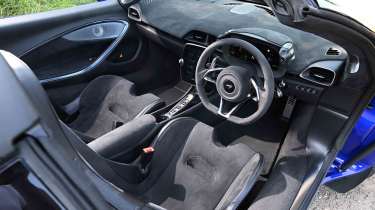
| Pros |
|
| Cons |
|
In a little more than a decade, McLaren has developed a formula for its mid-engined sports cars that means they’re easily recognisable and stand out from rival supercars. The Artura follows a familiar template, with a low, pointy nose, slender lights, large intakes to the sides and a rear end with lots of cutouts and grilles to help dissipate heat from the engine bay.
Another highlight are the dihedral doors, which open butterfly style to access the cabin – make sure you’re not parked too tightly against a wall or other object, otherwise you won’t be able to open them.
Interior and dashboard design
McLaren has focused on making the interior feel upmarket, but it focuses on a racing car-style appearance rather than lashings of soft materials. There’s lots of Alcantara trim instead, and metal switchgear throughout, although the layout feels as if it’s been fitted in where it can in places – the electric mirror adjuster is hidden away beneath the steering column near the centre console, for example. Carbon fibre touches can also be found inside, including the door jams, which reminds you of the car’s lightweight construction every time you get in or out.
Materials and build quality
The quality of the materials inside is first rate, and everything works well. Of special note are the gearshift paddles. As with other McLarens, manual shifts are handled by rocker switches behind the steering wheel, right side for up, left side for down. But while other makers often use two separate paddles, the Artura gets a single piece of chunky metal to grab, so the opposite paddle moves away from you as you shift. It’s a very satisfying set-up to use.
Infotainment, sat-nav and stereo
The Artura features a small eight-inch portrait touchscreen with a single control knob for volume to one side. The set-up is fine to use, but is set low on the dashboard, so it’s easier to operate when parked, otherwise it can be a bit of a distraction. There are shortcut buttons to each sub-menu and everything is logically arranged, although we did struggle to get Android Auto to work during our time with the car. Apple CarPlay was slow to connect, but worked fine after that.
The driver’s display looks sharper than the touchscreen, and is a more useful source of information on the whole. It’s controlled via a slender column stalk set below a similar stalk for the indicators, while there are two metal rocker switches on top of the instrument cowl that are used to control the suspension and powertrain modes. It’s a good way of having these functions close to hand, and to keep them separate, too. Switching between Comfort, Sport and Track modes sees the dashboard display change in appearance, with different speedometer and rev counter graphics for each mode.
“The Artura Spider features two additional toggle switches set into the header rail on either side of the rear view mirror. One is to lower the rear window, while the other opens the roof. This takes a slick 11 seconds to do, while the clear perspex buttresses are a neat addition that gives the Spider a visual difference to the Coupé.” – Dean Gibson, senior test editor
Boot space & practicality
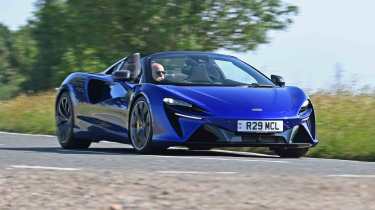
|
Pros |
|
| Cons |
|
The McLaren Artura is a two-seat, mid-engined supercar, so it’s not going to be practical in the typical sense. But it’s easy enough to get comfortable once you’re past the doors, and the space in the nose can fit a couple of soft bags.
Dimensions and size
The Artura is roughly the same size as a Ferrari 296, but the Lamborghini Temerario is longer and wider. It’s the smallest McLaren in the line-up, being 3cm shorter than a 750S, and 4.4cm less than the GTS. McLaren has fitted a nose lift as standard to raise the Artura’s front end to get it over kerbs and speed bumps.
| Dimensions | |
| Length | 4,539mm |
| Width | 1,976mm |
| Height | 1,193mm |
| Number of seats | Two |
| Boot space | 160 litres |
Driving position, seats & space in the front
The first hurdle to overcome with the Artura is negotiating the dihedral doors. The lift on their gas struts easily enough, but you need to be pretty agile to get around them and into the seats. It’s a little easier in the Spider with the roof down, and we found stepping into the car and swinging down into the seat is the easiest way in. There’s enough weight in the doors that they’re easy enough to close behind you.
Once in place, the snug cockpit feels racy, but there is plenty of adjustment on offer. The seat base slides manually, while the steering wheel is electrically adjustable, and the dial pod moves with the wheel so it remains visible in all positions. The view out is fine, although the low seating position means you might be reliant on other road users to see you if you’re pulling out of blind junctions, for example.
Storage is fine, with a narrow armrest bin featuring two USB sockets, and there are two narrow bins on either side of the drive selection buttons on the centre console. These are wide enough for a smartphone, while there’s another slot ahead of the starter button. There are modest door bins, and McLaren has designed them with a floor that curves up to the front, so items should simply roll around instead of falling out when you open the doors.

Boot space
The tightly packaged engine and hybrid system means that the back of the car is completely given over to the powertrain, so the only storage away from the cabin is the boot in the nose. This is good enough for a couple of bags and measures 160 litres, although if you’re carrying a charging cable then this will take up some room.
Reliability & safety
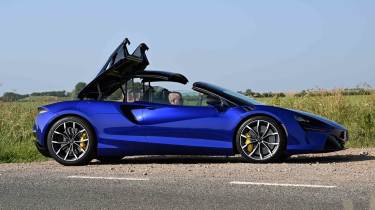
|
Pros |
|
| Cons |
|
There have been stories of poor reliability with cars such as the MP4-12C, but as the years pass, the reliability of McLaren’s cars has improved. So much so that the company offers a five-year, unlimited mileage warranty on the Artura.
On top of this, the drive battery is covered for six years (but only up to 75,000km, or 46,600 miles), and McLaren throws in five years of roadside assistance to give even more peace of mind.
Artura buyers also benefit from three years of servicing that’s included with the car, while service intervals are every 15,000 miles.
|
Key standard safety features |
|
Buying and owning
Our best buy: McLaren Artura Spider
The extra dimension that open-air driving provides means that the Spider is our choice over the coupé. There’s no compromise in performance, and the handling remains unaffected by the folded top, too.
McLaren Artura alternatives
As with Formula One, Ferrari is among McLaren’s key rivals in the supercar class, with the Ferrari 296 GTB and open-topped GTS offering a similar V6 turbo PHEV powertrain and hybrid performance. The Ferrari is pricier by around £50,000, although if that’s going to be a deciding factor on which one you buy, then you probably can’t afford either in the first place. The Lamborghini Temerario is the Huracan replacement, and it too is a PHEV, but this has a V8 unit and a greater bias towards petrol power over electricity.
Elsewhere, the Porsche 911 Turbo S hasn’t turned to PHEV power yet, but offers searing performance, while the Porsche 911 GT3 and GT3 RS versions of that car deliver sharper track-focused handling. The Aston Martin Vantage isn’t as pricey as the Artura, and is a more traditional front-engined, rear-drive machine, but still offers a sense of occasion.
McLaren Artura pictures
Frequently Asked Questions
There’s a five-year unlimited mileage warranty on the Artura, with the drive battery being covered for six years and 75,000km (46,600 miles). This should help allay any concerns about reliability, which has been patchy for McLarens in the past.

